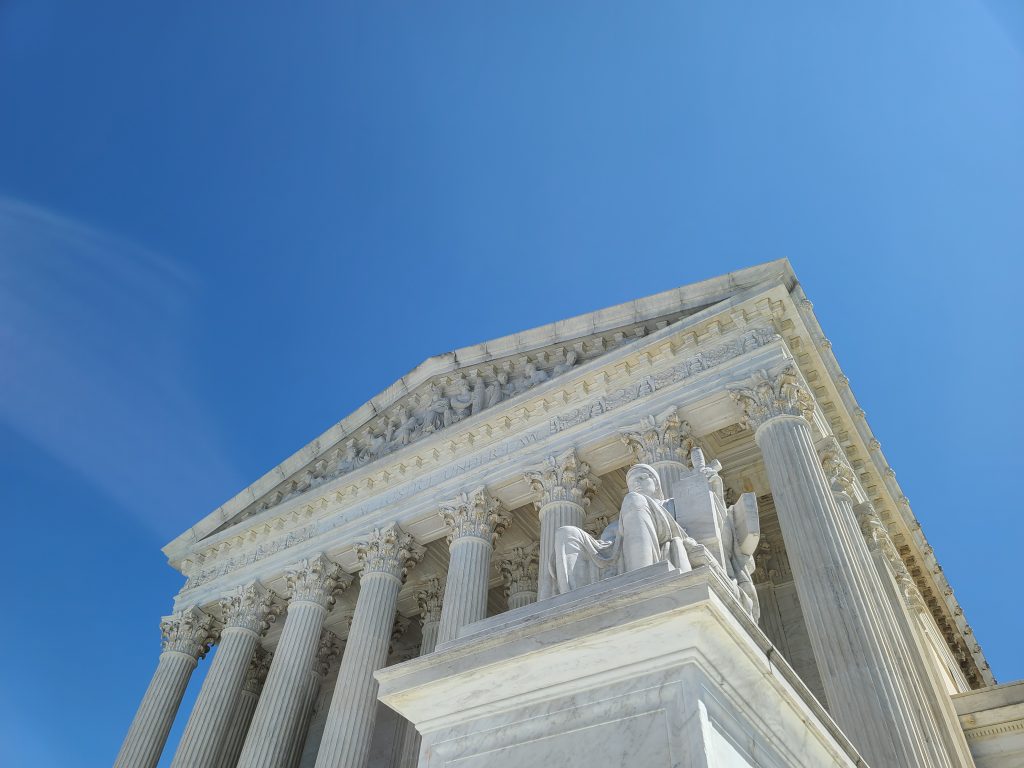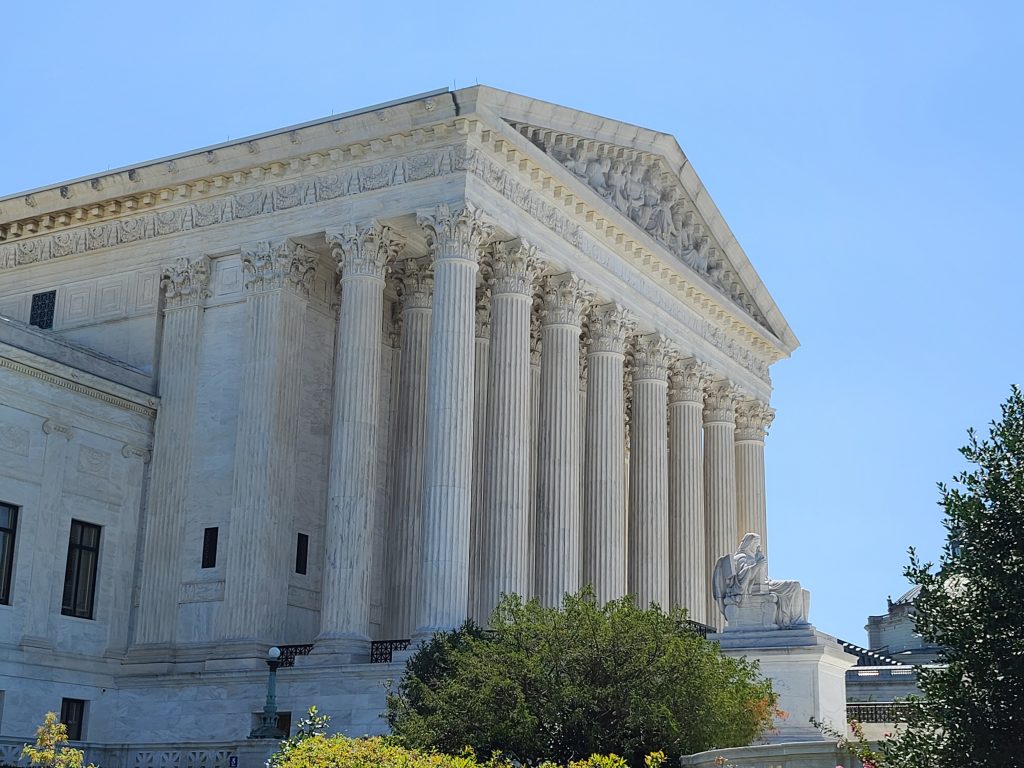This week the Supreme Court changed the landscape of guns in America.
With its ruling in New York State Rifle and Pistol Association v. Bruen, the Court struck down restrictive “may issue” gun carry permit regimes nationwide. That alone will directly affect nearly a quarter of Americans.
But, more importantly, the ruling also elaborated on how Second Amendment cases should be judged moving forward. That will make the next raft of gun cases good tests of how lower courts plan to respond to the Court’s rebuke. Contributing Writer Jake Fogleman takes a look at the four cases most likely to be decided next and how Bruen might affect them.
Plus, National Review’s Charles Cooke explains the ruling and the new federal gun law.

Analysis: A Look at Other Pending SCOTUS Gun Cases After Bruen [Member Exclusive]
By Jake Fogleman
On Thursday, the Supreme Court issued the most significant Second Amendment decision in more than a decade when it struck down New York’s restrictive “may-issue” standard for gun-carry permit issuance.
Justice Clarence Thomas, writing on behalf of the Court, found that allowing government officials broad discretion in determining when an otherwise law-abiding person can be issued a carry permit is unconstitutional. The ruling essentially establishes “shall-issue” permitting as the constitutional floor for gun carry nationwide. But beyond confirming a constitutional right to bear arms, the opinion explained the test lower courts will be expected to review Second Amendment cases by moving forward.
“When the Second Amendment’s plain text covers an individual’s conduct, the Constitution presumptively protects that conduct,” Thomas wrote. “The government must then justify its regulation by demonstrating that it is consistent with the Nation’s historical tradition of firearm regulation. Only then may a court conclude that the individual’s conduct falls outside the Second Amendment’s ‘unqualified command.'”
This test, reliant on the text and informed by history, will have jurisprudential implications far beyond the right to bear arms outside the home. And with four other Second Amendment cases currently awaiting Supreme Court review, we could see the extent of those implications very soon.
Here’s a review of those cases awaiting a cert grant and what their fate might look like in a post-Bruen world.
At issue in Young is a challenge to Hawaii’s may-issue gun carry regime along the lines of the challenge the court just ruled on in NYSRPA v. Bruen, though Hawaii’s law is allegedly applied much more strictly.
“Unlike the New York scheme, where some permits actually have been issued, Hawaii’s scheme is a permitting system in name only, because the statute has been used to deny all permit applications during the nine years this case has been in litigation,” the challengers wrote in their petition for Supreme Court review.
In an en banc ruling in 2021, the Ninth Circuit Court of Appeals held that the Second Amendment does not apply outside the home at all. The Court’s decision in Bruen invalidates this holding. Expect this decision to be subject to a grant, vacate, and remand (GVR) order by the Court or otherwise kicked back to the lower courts, where the petitioners will ultimately be successful.
This case concerns Maryland’s “assault weapons” ban and whether or not a government can criminally prohibit a category of arms in common use.
The Fourth Circuit upheld Maryland’s ban in September of 2021 after applying a two-tiered balancing test that the Justices in Bruen explicitly rejected.
“If the last decade of Second Amendment litigation has taught this Court anything, it is that federal courts tasked with making such difficult empirical judgments regarding firearm regulations under the banner of ‘intermediate scrutiny’ often defer to the determinations of legislatures,” Justice Thomas wrote. “But while that judicial deference to legislative interest balancing is understandable—and, elsewhere, appropriate—it is not deference that the Constitution demands here. The Second Amendment ‘is the very product of an interest balancing by the people’ and it ‘surely elevates above all other interests the right of law-abiding, responsible citizens to use arms’ for self-defense. It is this balance—struck by the traditions of the American people—that demands our unqualified deference.”
Because the test used to uphold Maryland’s assault weapons ban was summarily dismissed in Bruen, this case is ripe for revisiting too. The Court could potentially agree to hear the case, but more than likely, it will GVR back to the Fourth Circuit for rehearing under the newly established test.
A textual and historical analysis makes it more likely that Maryland’s assault weapons ban will get struck down, given the popularity of AR-15s and other banned guns. Still, it will depend on how it is applied.
This case deals with California’s prohibition on possessing ammunition magazines capable of holding more than ten rounds and the state-mandated confiscation of magazines owned before the ban.
An en banc panel for the Ninth Circuit upheld California’s ban under the same two-step interest balancing test, overturning a district judge’s earlier decision to strike the law.
The decision notably featured a fiery dissent from Judge Lawrence VanDyke, who chastised the test used in the Ninth Circuit’s decision.
“It should be presumptively unconstitutional to burden constitutional rights,” Judge Lawrence VanDyke wrote. “But looking at our court’s cases, you would assume that any burden on the right to bear arms is presumptively permitted. I’ve described before how our circuit’s version of Second Amendment’ heightened’ scrutiny has no height. It is practically indistinguishable from rational basis review.”
Expect this case to similarly get GVR’d, where the chances of California’s ban on magazines being struck down increases significantly under a text and history test given, again, how common the banned magazines are.
Similar to Duncan v. Bonta, this case seeks to challenge New Jersey’s ban and confiscation of ammunition magazines capable of holding more than ten rounds.
A divided three-judge panel of the Third Circuit upheld New Jersey’s ban in 2018. A petition for rehearing en banc was denied in 2020. The fate of this case will probably be similar to Duncan, with a likely GVR order from the Court.
In sum, the Court’s rejection of two-step scrutiny tests in favor of the requirement that lower courts apply a “text, as informed by history” test should result in a much more favorable legal environment for gun-rights advocates moving forward beyond simply the right to carry a firearm beyond the home. This new test places a steeper burden on government officials seeking to justify a particular gun control law. Those laws not deeply rooted in the tradition of gun regulation near the time of the Second Amendment’s ratification, or that of the Fourteenth Amendment, could have a hard time passing muster.
But as with the test initially contemplated in Heller and later McDonald, a lot will depend on how lower court judges decide to apply it moving forward. And how willing the Supreme Court will be to step in when they don’t like how those judges handle gun cases.
Podcast: National Review’s Charles Cooke Reacts to Supreme Court and Senate Gun News [Member Early Access]
By Stephen Gutowski
Two of the biggest gun stories in decades came to a head this week. The Supreme Court’s anticipated Bruen decision invalidate “may issue” gun carry permit laws nationwide just before the federal government passed its first new gun restrictions in a generation. These shifts are monumental.
That’s why this week we’re joined by one of the top pro-gun thinkers out there: National Review’s Charles Cooke.
Cooke has already written extensively on the ruling and the legislation. He said both would have far-reaching consequences.
He argued the ruling puts the Second Amendment back on par with the First Amendment. It will not only eliminate restrictive “may-issue” gun-carry permitting, but it will cast a shadow over all kinds of other modern gun laws. Any regulation without a clear place in the founding-era tradition of gun laws will have a difficult time in court.
As for the new federal gun law, Cooke argues the bill was poorly drafted with multiple confusing provisions and apparent drafting errors. He questioned why domestic violence records for “dating partners” are expunged after five years but no other records are. He noted how expansive it will be to make it illegal to sell guns to anyone with a juvenile felony conviction or involuntary commitment or how precarious the new gun dealing license requirements could make selling even a single firearm.
Plus, Contributing Writer Jake Fogleman explains a new lawsuit against Colorado police who killed a concealed carrier after he stopped an active shooter.
You can listen to the episode on your favorite podcasting app or by clicking here.
Video of the show is also available on our YouTube channel.

Analysis: What Impact Will the Supreme Court’s Gun Ruling Have? [Member Exclusive]
By Stephen Gutowski
The Supreme Court has issued its first significant Second Amendment ruling in over a decade, but what does it mean?
The immediate impact of the New York State Rifle and Pistol Association v. Bruen ruling will be on gun-carry laws in places like New York, California, and Massachusetts–anywhere that currently employs a “may-issue” permitting system for concealed carry. Those laws will be struck down or repealed in line with the Supreme Court’s ruling over the coming weeks and months. The legislatures will have to figure out how to replace them.
Instead of empowering government officials to make subjective judgments on who they feel has a “good reason” to carry a gun, denying the vast majority of otherwise qualified applicants in practice, state lawmakers will have to find another system for gun carry. Given the political opposition to gun carry in those states, it’s unlikely they will join most of the country and move to a permitless system. But they won’t have to anyway since the Supreme Court has left open the open of adopting a “shall issue” system, which keeps in place many of the requirements of “may issue” laws, such as a background check and training, but removes the ability of the issuing official to deny applicants subjectively.
While the Court only identified a handful of states with the now-unconstitutional policy, they are some of the most populous states in the nation and upwards of one in five Americans live there. So, the consequences of that short-term change will be immense.
For context, Florida and New York have similar populations, but their divergent gun-carry permitting schemes have left the Sunshine state with more than 2.3 million concealed-carry permit holders and the Empire state with 37,800. If New York and the other “may issue” states end up with a process closer to Florida’s “shall issue” law, millions more people will likely become licensed to carry over time.
Of course, the deep blue states with gun-carry laws affected by the ruling are unlikely to pass laws that exactly mirror gun-friendly Florida. But we don’t have to search too hard to see where those jurisdictions will likely end up.
That’s because Washington, D.C. has already gone through this transition process in response to multiple losses in federal court. First, the city saw its total ban on gun carry struck down. Then its “may issue” regime met the same fate a few years later.
Today, D.C. has a “shall issue” permitting system. However, it’s likely the strictest in the country.
Unlike other “shall issue” jurisdictions, including its neighbor Virginia, the city created a series of unique requirements and restrictions. Instead of merely requiring a background check and commonly available gun safety training, such as the popular NRA basic pistol course, D.C. created its own unique training requirements and certification program.
The result is a 16-hour training course which only a few trainers offer at a cost of several hundred dollars. That’s on top of the $110 those seeking a permit have to spend on application and fingerprinting fees.
Those who get permits also face a unique combination of restrictions on where they can legally carry. The gun-free zones include public transit, permitted events or events big enough that they should require a permit, and even areas surrounding those under special diplomatic protection as they move around the city.
Many of these restrictions were not brand new ideas. Instead, D.C. cribbed each from “shall issue” laws in places such as North Carolina and Florida and combined them into what is effectively the most difficult “shall issue” permitting process in the nation.
That’s likely why the city has only issued a few thousand permits since the law’s adoption. Of course, that’s still several thousand more than the city was issuing under its “may issue” law.
States like New York and California will almost certainly copy the city’s example as they search for ways to continue to restrict gun carry within the bounds set by the Supreme Court. They’re also likely to refuse to recognize permits from other states and, most likely, refuse to issue their own permits to non-residents (something federal courts forced D.C. to do, but which the Supreme Court did not touch on in its ruling).
All of these changes will limit the number of people legally allowed to carry a concealed gun in the affected states. However, millions more Americans are likely to be able to legally carry despite all of that.
But the ruling in Bruen is likely to have a more significant long-term impact than changing the way a handful of states regulate gun carry, even if that specific change does impact millions of Americans. That’s because the Court elaborated on the proper standard for deciding all Second Amendment cases moving forward. It explicitly rejected the “two-step” standard of review many lower courts had used to uphold restrictive gun laws and pointed instead to one based on the Second Amendment’s text and whether the restriction fits with historical gun regulations.
The Court then analyzed the New York case on that basis in a further example of how it wants to see gun cases decided. Ultimately, that could imperil any of the modern gun restrictions in the same states that have these “may issue” gun-carry laws. That could lead to a streak of gun laws being struck down.
That’s not a guarantee, though. Many observers thought the same thing 14 years ago when the Supreme Court established the Second Amendment protected an individual right to keep and bear arms in the landmark Heller case. The wave of invalidated gun laws never materialized.
Lower courts adopted their own methods of reviewing cases that ended with most controversial gun laws being upheld during challenges. The new standard, which relies at least in part on judges examining, often less-than-clear, historical records for analogous historical gun laws, seems ripe for disagreement over which rules are rooted in the American tradition of gun regulation.
The Supreme Court may have to step in fairly regularly to ensure lower courts review Second Amendment cases the way it wants them to.
Several cases are already pending, which will provide a good indication of how this all plays out. Duncan v. Bonta and ANJRPC v. Platkin, which challenge California and New Jersey’s magazine confiscation scheme, respectively; Bianchi v. Frosh, which challenges Maryland’s “assault weapons” ban; and Young v. Hawaii, which challenges Hawaii’s open carry permitting system, are the cases to watch. How they move through the courts in a post-Bruen world will be very instructive.
That’s it for now.
I’ll talk to you all again soon.
Thanks,
Stephen Gutowski
Founder
The Reload







